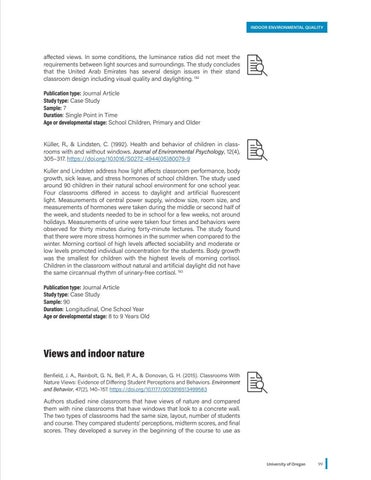INDOOR ENVIRONMENTAL QUALITY
affected views. In some conditions, the luminance ratios did not meet the requirements between light sources and surroundings. The study concludes that the United Arab Emirates has several design issues in their stand classroom design including visual quality and daylighting. 192 Publication type: Journal Article Study type: Case Study Sample: 7 Duration: Single Point in Time Age or developmental stage: School Children, Primary and Older Küller, R., & Lindsten, C. (1992). Health and behavior of children in classrooms with and without windows. Journal of Environmental Psychology, 12(4), 305–317. https://doi.org/10.1016/S0272-4944(05)80079-9 Kuller and Lindsten address how light affects classroom performance, body growth, sick leave, and stress hormones of school children. The study used around 90 children in their natural school environment for one school year. Four classrooms differed in access to daylight and artificial fluorescent light. Measurements of central power supply, window size, room size, and measurements of hormones were taken during the middle or second half of the week, and students needed to be in school for a few weeks, not around holidays. Measurements of urine were taken four times and behaviors were observed for thirty minutes during forty-minute lectures. The study found that there were more stress hormones in the summer when compared to the winter. Morning cortisol of high levels affected sociability and moderate or low levels promoted individual concentration for the students. Body growth was the smallest for children with the highest levels of morning cortisol. Children in the classroom without natural and artificial daylight did not have the same circannual rhythm of urinary-free cortisol. 193 Publication type: Journal Article Study type: Case Study Sample: 90 Duration: Longitudinal, One School Year Age or developmental stage: 8 to 9 Years Old
Views and indoor nature Benfield, J. A., Rainbolt, G. N., Bell, P. A., & Donovan, G. H. (2015). Classrooms With Nature Views: Evidence of Differing Student Perceptions and Behaviors. Environment and Behavior, 47(2), 140–157. https://doi.org/10.1177/0013916513499583
Authors studied nine classrooms that have views of nature and compared them with nine classrooms that have windows that look to a concrete wall. The two types of classrooms had the same size, layout, number of students and course. They compared students’ perceptions, midterm scores, and final scores. They developed a survey in the beginning of the course to use as
University of Oregon
99

